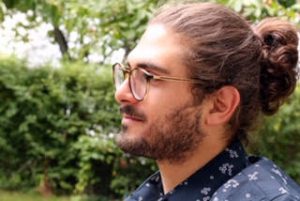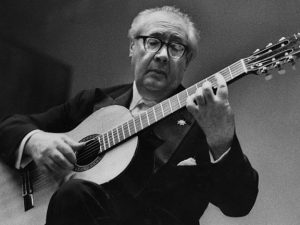
BY NECDET BALKIR GÖKA (ME/IV) balkir.goka@ug.bilkent.edu.tr
In a coastal town, the beautiful, magical melodies of “Recuerdos de la Alhambra” echo in a clay-colored Spanish palace. Everyone knows the name of the guitarist, but he is not playing for the audience – he is playing only for his personal pleasure. He takes up his guitar and starts to play each note with incredible precision and inexpressible emotion. The guitar is like a part of his body, or his beloved; the position in which he plays the guitar is almost as if he were hugging it. His name is Andrés Segovia, and he is one of the most influential guitarists of all time.
Andrés Segovia was born in 1893. At that time, the guitar was not a highly respected instrument; because of its very limited tonal spectrum, classical composers did not use it in their works. Following in the footsteps of Francisco Tárrega, an influential guitarist and composer who died in 1909, Segovia wanted to create a guitar repertoire that made use of the technical capabilities of the guitars designed by the 19th-century luthier (stringed-instrument maker) Antonio de Torres. With these guitars, it became possible to play highly polytonic melodies with both rhythm and lead sections. Torres’s advancements put the guitar at the center of Spanish classical music. Building on this, Tárrega and after him Segovia worked to create a classical guitar repertoire. Segovia did this in part by transcribing and playing compositions that were not originally written for guitar, thus demonstrating that the guitar was more than adequate for playing such music. However, since the guitar could be considered a new voice in classical music at the time, no one had enough technical knowledge to play classical arrangements. Segovia changed this by creating new playing techniques. Now, every classical guitar player uses the techniques he developed.
Segovia also started to commission new pieces for the guitar. Although he did not yet have the experience or status to work with famous composers, younger and lesser-known composers wrote pieces for him. Segovia had a romantic, conservative approach to the guitar; he wanted to play Spanish melodies imbued with romanticism. He once commented, “The guitar is an instrument for playing compatible sounds. But it doesn’t mean that atonal pieces, which are very popular nowadays, could not have been played with the guitar. A French composer, I don’t want to mention his name, said that one of his compositions should be played by punching the piano. You could not do such a thing with the guitar because it is very delicate and poetic.” These words explain his unique approach to the instrument.

Until the time of Segovia, the guitar was not generally played in the concert hall. Tárrega and his circle believed that the sound of a guitar could not be heard at long distances; therefore, playing in a concert hall would mean that no one would hear or listen to you. Segovia thought that artists who adopted such ideas had a “superficial understanding” and were “simple-minded.” His fourth concert took place in the Palau de la Música Catalana, which had an audience capacity of more than a thousand. After the concert, the reviews were brilliant, proving Tárrega wrong. We can today hear the guitar in large concert halls, without any microphones, thanks to the technical trial Segovia conducted at this concert. This first step revivified the guitar community. Luthiers started to experiment with increasing the loudness and quality of the sound of their instruments. Segovia used three main guitars during his career; these were made by Manuel Ramírez, Hermann Hauser and Ignacio Fleta. They were not just musical instruments, but instead the result of a scientific understanding of sound and its creation.
Today, more than 30 years after Segovia’s death in 1987, we hear the guitar extensively in both popular and classical music as a result of his vision. His career was a milestone in the history of music because, looking at popular music after his lifetime, we can easily see that the guitar is the most important instrument in the industry. I want to conclude this week’s column with some suggestions for listening. To really understand Segovia’s music, you have to listen very carefully and try to internalize the feeling he conveys. For me, the most influential pieces are: the Prelude in C Minor (written by Johann Sebastian Bach), “Recuerdos de la Alhambra” (written by Francisco Tárrega) and Danza Española, Op. 37, No. 5 (written by Enrique Granados).
